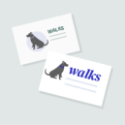Write your dog walking business plan
The first step to take in any dog walking business is to create a solid business plan.
It’ll help you set out your strategy and your objectives and allow you to create realistic goals for success. A good business plan also helps prospective clients or loan assessors to get an understanding of where you want to take your business in the first few years.
A business plan usually includes the following four key areas:

Executive summary – An executive summary is a short, clear overview of your business, sometimes called an Elevator Pitch. It should provide an at-a-glance summary of you, your business, what you want to achieve and why you’re doing it in the first place.

Opportunity – To make your business a success you need to show you understand the opportunity in front of you. What other businesses like yours operate in the area? Is it a crowded market or a clear blue ocean? How many dogs and dog owners are there in your area? This section explains how your business will make its mark and stand head and shoulders above your competition.

Execution – This is how you’ll build your business for success. Explain your goals, your business’ sales, marketing and logistics strategies, and back these sections up with concrete data to prove you’re well informed and are making decisions based on real evidence.

Financial plan – Ultimately, it’s all about the bottom line. No business plan is complete without a solid financial forecast. This should include your budget, your incomings and any expected outgoings. It’s your proof point that you understand the numbers needed to make your business profitable..


Training and qualifications
While there is no formal qualification required before becoming a dog walker, your customers are placing their trust in you to look after an important member of their family, so they expect professionalism and experience at all times.
You can gain experience in dog walking by volunteering at local centres like the Dogs Trust or the RSPCA, where training is often provided. Other skills and accreditations which your clients may expect from their professional dog walker could be in areas such as animal first aid, animal behaviour and psychology and dog handling.
If you’ve been provided with a key to pick up people’s dogs from their homes when the owner isn’t around, or if your business also extends to pet sitting as well as dog walking when the owner is on holiday for example, you should apply for a basic disclosure check. It shows your customers that you have no outstanding warrants or criminal record and could help show that you can be trusted with their homes and pets while they’re gone.
There are two main types of basic disclosure check:
- Basic disclosure, provided by Disclosure Scotland
- Disclosure and Barring Service in England and Wales
Other, more formal qualifications recommended by the Dogs Trust include a Level 2 Certificate Of Technical Competence In Dog Walking.
Laws and regulations
As a professional dog walker, your clients are putting their trust in you to look after their pets. While they’re in your care, they are your responsibility. That means there are certain laws which apply to you and your dog walking business that you must be aware of. These laws include:

Animal Welfare Act
The Animal Welfare Act 2006 in England and Wales and the Animal Welfare Act (Scotland) 2006 places a duty of care on pet owners and others responsible for animals to ensure that the welfare needs of their animals are met.
The welfare needs of the animals in your care includes:
- need for a suitable environment
- need for a suitable diet
- need to be able to exhibit normal behaviour patterns
- need to be housed with (or apart from, as the case may be) other animals
- need to be protected from pain, suffering, injury and disease

Dog fouling
In England and Wales, the Anti-Social Behaviour, Crime and Policing Act 2014 made it an offence to leave dog mess without cleaning it up in certain areas. Failure to clean up after the dog in your care can result in an on-the-spot fine of up to £80 and a maximum fine of up to £1000.
In Scotland, The Dog Fouling (Scotland) Act 2003 means that in public and communal spaces (excluding agricultural land), it’s an offence not to clear up after the dogs in your care, with a maximum fine of £500.

Dangerous dogs
As well as prohibiting the ownership of certain types of dog commonly bred for fighting, the Dangerous Dogs Act 1991 also makes it an offence to allow a dog to be ‘dangerously out of control’, which could include physical injury to humans.
In addition, the Control of Dogs Order 1992 ensures that any dog in a public place must wear a collar with the name and address of the owner engraved or written on it, or engraved on a tag, and the Dogs (Protection of Livestock) Act 1953 prohibits dogs from worrying, chasing or attacking livestock including cattle, sheep, goats, pigs, horses and poultry on agricultural land. If a dog in your care does this, the owner of the land may have the right to shoot the dog, resulting in obvious and serious ramifications for your dog walking business.
This list isn’t exhaustive and the local laws in your area can vary place to place. Some local authorities only allow for a certain number or dogs to be walked in local areas like parks at any one time, for example, so it’s always best practice to check with your local council or authority to make sure your business is fully compliant with the latest laws and regulations.
You can find your local council and how to contact them at https://www.gov.uk/find-local-council
How much should I charge as a dog walker?
According to Glassdoor, the average rate for a dog walker in the UK is £10 per dog, per hour. This may vary by area and demand, so remember to do your research into your local area and what any potential competitors may be charging.
Think about the number of dogs you can comfortably walk at any one time. This may also depend on your local area, or even your level of business insurance which could limit the number of dogs you’re able to manage at once.
So if you were to walk three dogs at one time for an average of four hours per day, five days per week, you could be making a monthly revenue of £2,400 before tax – not to be sniffed at!
Marketing your dog walking business
To make your dog walking business a success you need customers – both two and four-legged. So what’s the best way to get a solid base of customers barking up your tree for your services? Start with a marketing plan.
Dog walker’s marketing plan
A marketing plan is your guide to how you’ll meet your business objectives by getting your name out to an audience and keeping your diary busy with paying clients.
Typically, a marketing plan will include:

Goals
What do you want to achieve and by when? It could be to make a certain amount of money in year one, or it could be to have a strong group of regular customers after six months. Track your goals and make sure they’re SMART (specific, measurable, achievable, realistic and timely) so you can make sure you’re on the right track.

Research
Look at any other dog walkers in your area. What are they doing well, and what can you do better? How can you better serve the local area and how can you compete with them? On service? Price? Answering these questions will help give you an insight into marketing your business in the best way.

Marketing techniques
How are you going to reach your customers? Firstly, think about where your audience is most likely to see and engage with your ads in the first place. Some of the most common ways to advertise a dog walking business could be:
- Social media – Ever stopped scrolling on Facebook or Instagram because of a cute animal video? Chances are your target audience has too. Sharing social images and videos can be a great marketing tool for dog walkers – just get permission from your clients to photograph their dog first.
- Website – now more than ever it’s important to have an online presence to let your customers find you. Take a look at AXA’s guide to getting your business online to find out more about building a website and getting your Search Engine Optimisation right.
- Flyers and posters – sometimes you don’t need to teach an old dog new tricks. Handing out flyers might seem old fashioned but it can be a good way to get your business name in front of customers in your local area. Ask if you can put your flyers up in post offices, shops and libraries nearby.
- Word of mouth – never under estimate the power of a good word or a recommendation from a friend. If you do a good job for one customer, they’ll likely tell their friends. But if you want word of mouth referrals your levels of service need to be top notch – no one ever referred a company who treats customers poorly.
- Diversify – want to make sure your dog walking business stands out from the pack? Consider diversifying your offering – could you also provide a pet sitting service, or dog grooming as well as walking? If you have kennels, could you offer pet boarding while their owners are on holiday? Think about what you can offer that your competitors don’t currently.

KPIs
These are your Key Performance Indicators. How are you going to know that your strategy is working? And how will you tweak your plan if you aren’t hitting your KPIs?


Business insurance for dog walkers
They say you should never work with children or animals, so as a professional dog walker your business faces some potential hazards that other business don’t. These could include, for example, if the dog you’re responsible for gets injured or causes damage to someone's property, or if they injure another animal or person while in your supervision.In these cases, you could be liable for accidents or injuries and a dog walking business insurance policy can protect you in case something goes wrong.
Common dog walkers’ insurance covers include:
- public liability insurance can cover you if a member of the public or a client is accidentally injured or if their property gets accidentally damaged while dealing with your dog walking business
- employers' liability insurance is usually a legal requirement if you have any employees
- business equipment cover covers any expensive equipment you use for your business, like a laptop for example
- personal accident cover can pay compensation for accidental injury or even death
- van insurance if your business uses a van to transport dogs to and from the park
Not sure where to start?
Check out the AXA Business Insurance Wizard. Just answer four simple questions and you’ll get a list of the insurance you’ll need as a business consultant.
Visit the Business WizardReady to start a dog walking business?
SStarting a dog walking business isn’t a walk in the park. Your clients will be putting their furry best friends in your care, and that’s something worth protecting. Get started with AXA’s business insurance for dog walkers.